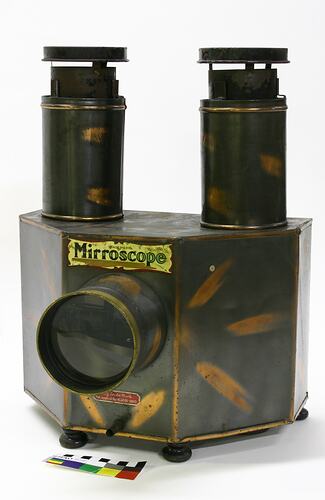Summary
Mirroscope, alternative names opaque projector, episcope or magic lantern.
The mirroscope was made by the Buckeye Stereopticon Co., Cleveland, Ohio, USA. Four models were offered by Gamages Ltd (London) in 1913, at prices from 15 - 42 shillings. This example is an improved model, with the addition of the two heat stacks directly above the light bulbs, designed to allow the heat to escape while preventing light from entering.
Items to be projected are illuminated by two light sources (burners). The light from the item is then focussed by an adjustable lens and projected on a screen or wall. Usually this object would be a postcard, photo, or other printed matter, but objects such as coins or leaves could also be projected. Heat from the light sources is removed using the two chimneys, located directly above the light sources, thus preventing any extra light entering.
Other Mirroscopes had a standard two-prong plug, but the cord on this one terminates in a screw base which fits into a light bulb socket.
This particular Mirroscope still has two old teardrop-shaped bulbs inside - the kind with the little point at the top and they both work (at date of writing).
This lantern projector is part of the Francis Collection of pre-cinematic apparatus and ephemera, acquired by the Australian and Victorian Governments in 1975. David Francis was the curator of the National Film and Sound Archive of the British Film Institute as well as being a co-founder of the Museum of the Moving Image in London, which was operational between 1988 and 1999.
Physical Description
A six-faced object with a lens attached to the front panel. There are two cowls on the top to release heat produced by light source inside object. Rear panel is hinged at the bottom and opens to reveal a dual burner and mirrored reflector plates. Supported underneath by four feet.
More Information
-
Collection Names
-
Collecting Areas
-
Acquisition Information
Loan & Subsequent Donation from Australian Film Institute (AFI), Mr David Francis, by Nov 1990
-
Manufacturer
Buckeye Stereopticon Co, Cleveland, Ohio, United States of America, 1910
-
Retailer
-
Collector
Mr David Francis, London, Middlesex, England, Great Britain, 1990
-
Inscriptions
Front: 'MIRROSCOPE TRADEMARK / REG. TRADEMARK PAT. APPLIED FOR #13081 - 1910.'
-
Classification
-
Category
-
Discipline
-
Type of item
-
Overall Dimensions
322 mm (Length), 322 mm (Width), 432 mm (Height)
With chimneys.
-
References
[Link 1] - accessed 22 September 2008
[Book] Robinson, David, et al. 2001. Encyclopaedia of the Magic Lantern., 2001, 195 Pages
-
Keywords

